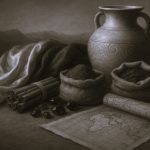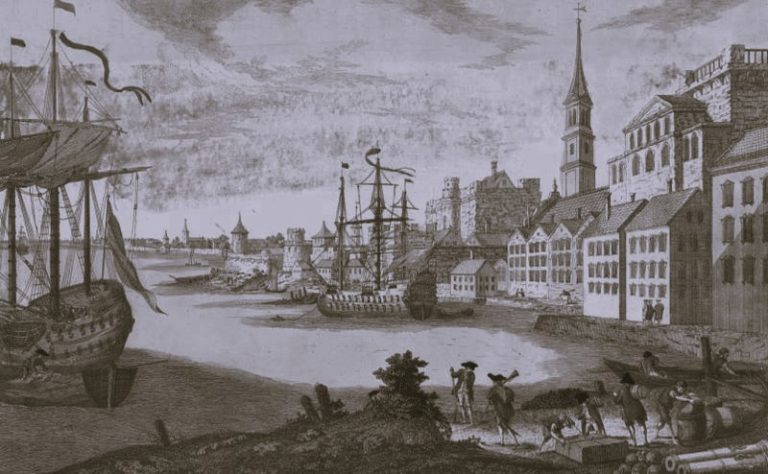
Aristotle studied developing organisms, among other things, in ancient Greece, and his writings shaped Western philosophy and natural science for greater than two thousand years.
By Dorothy Regan Haskett, Valerie Racine, and Joanna Yang
Aristotle spent much of his life in Greece and studied with Plato at Plato’s Academy in Athens, where he later established his own school called the Lyceum. Aristotle wrote greater than 150 treatises on subjects ranging from aesthetics, politics, ethics, and natural philosophy, which include physics and biology. Less than fifty of Aristotle’s treatises persisted into the twenty-first century. In natural philosophy, later called natural science, Aristotle established methods for investigation and reasoning and provided a theory on how embryos generate and develop. He originated the theory that an organism develops gradually from undifferentiated material, later called epigenesis.
Aristotle was born in 384 BCE in Stagira, a coastal town in the Chalcidice peninsula of northern Greece. His mother was Phaestis, who came from a wealthy family on the island of Euboea, and his father was Nicomachus, who was a personal physician to King Amyntas of Macedon. Nicomachus boasted of descent from the Asclepiads, who were devotees of Asclepius, the Greek god of healing and medicine. The Asclepiads valued empirical observations, and that culture made Aristotle familiar with biological studies in his early years. Both parents died when Aristotle was young, and he went to live with Proxenus of Atarneus, who was married to Aristotle’s older sister. At the age of seventeen or eighteen, Aristotle went to study at Plato’s Academy in Athens, where he stayed for twenty years until Plato died in 347 BCE.
The Academy trained students in mathematics and rhetoric. Although Aristotle spent two decades at the Academy, few records survived about his time there or his relationship with Plato. During Aristotle’s time at the Academy, he established himself as a philosopher and author, expressing reservation about some aspects of Plato’s doctrines, and dissenting from some of the Academy’s positions. After Plato died, Aristotle left with Xenocrates, a senior member of the Academy, to the island of Assos off of Asia Minor on the coast of what later became Turkey, where they founded a new school.
Aristotle continued his work from the Academy and began to research marine organisms with the patronage of Hermias, the ruler of Assos. Aristotle stayed at Assos for about three years until Hermias died in 341 BCE, after which Aristotle moved to the costal island of Lesbos, where he married Pythias, the niece of Hermias. They had a daughter and named her Pythias after her mother. Aristotle continued his philosophical studies and his empirical research in marine biology with Theophrastus, a native of Lesbos who had also studied at the Academy. In Assos and Lesbos, Aristotle admonished his students to study what some deemed even the lowliest of animals.
In 343 or 342 BCE, Philip of Macedonia enticed Aristotle to come to Pella, the capital of Macedonia, to tutor his son Alexander, who later became Alexander the Great. There is little information about Aristotle’s time in Macedonia, but Philip rebuilt Stagira, Aristotle’s birthplace, a city that Philip had previously destroyed. In 335 BCE, Aristotle returned to Athens after an absence of about twelve years, and there he opened his own school called the Lyceum, which featured a more empirical natural philosophy compared to that taught at Plato’s Academy. In 336 BCE, Philip of Macedonia died, and his son Alexander became king at about the age of twenty. Aristotle’s wife Pythias died, and later Aristotle found a companion in Herpyllis, who gave birth to a son they named Nicomachus, after Aristotle’s father.
Aristotle wrote many works on subjects including physics, metaphysics, poetry, theater, music, logic, rhetoric, politics, government, ethics, biology, and zoology. Of the roughly one-hundred to two-hundred works attributed to Aristotle by his contemporaries, roughly less than fifty survived into the twenty-first century. Aristotle created a comprehensive system of Western philosophy that encompassed morality and aesthetics, logic and science, politics and metaphysics. Aristotle’s theories on physical sciences shaped medieval scholarship, and they persisted into the Renaissance. His work contains the earliest recorded formal study of logic. Aristotle’s biological writing comprises approximately one-fourth of his surviving works.
Due to the lack of a clear chronology, possible revisions from his students, and incomplete collections, scholars struggled to analyze Aristotle’s intellectual development from his treatises. The dating of the treatises is uncertain because they have undergone at least two revisions. The first one occurred during Aristotle’s time, when he made them into teaching courses at the Lyceum. The second one occurred during the first century BCE, at least two centuries after Aristotle’s death, when Andronicus of Rhodes edited and rearranged the rediscovered manuscripts by subject. Aristotle’s philosophy as a whole divides roughly into three periods: Aristotle’s defense of Plato’s theories until 347 BCE, critical analyses of Plato between roughly 347 and 335 BCE, and the development of Aristotle’s own philosophy after roughly 335 BCE.
Aristotle’s biological works form a group with frequent reference to each other, and they indicate the order in which they are to be studied, not the order in which they were written. There are three main works: Parts of Animals, Generation of Animals, and Historia Animalium (History of Animals) and several smaller works or monographs that include Progression of Animals, Movement of Animals (or Motion of Animals), essays collected as Parva Naturalia, and De Anima or Psychology, which constitutes a bridge between biology and metaphysics.
Aristotle developed a general philosophy of science that included an account of explanation and causation in which he outlined four kinds of change or movement of a thing or substance that he called the four aitia (causes). Aristotle uses the Greek word aition, (αιτιον) or plural aitia (αιτια), which translates in English as cause, reason, or change. To Aristotle, aition was something one could cite to answer a why question, which has different meanings depending on the context. Readers in the twentieth and twenty-first centuries often interpreted the concept of cause in the sense of cause-and-effect, but Aristotle adopted a more general sense. The first cause, the material cause, is the matter that constitutes a thing. The second cause, the formal cause, is the design or pattern that gives form to the matter. The third cause, the efficient cause, is the entity that gives the matter the form. The forth cause, the final cause, is the end, or purpose, of the synthesis of form and matter.
A common example used to illustrate Aristotle’s division of causes became that of a sculptor creating a statue of the Olympian god, Hermes. In this example, to make a statue of Hermes, the material cause is the bronze matter out of which the sculptor carves the statue. The formal cause is the shape of Hermes, which is the design that gives the statue its form. The efficient cause is the action of the artist who shapes the piece of bronze into the form of Hermes. The final cause of the statue is the purpose for which the sculptor created it, such as to honor Hermes.
Aristotle discussed the four causes is in Physics II 3, and the application of his theory of causation to the study of living forms is found in Book I of The Parts of Animals. Here, Aristotle proposed principles of investigation, or the methodology for studying living organisms, and he emphasized the importance of final cause, the design or purpose called a teleological explanation in the life sciences. Aristotle claimed that every living thing consists of two intrinsic parts: primary matter (ουσια) and substantial form (ειδος). He used those principles to study the primordial elements of nature of which animal bodies are composed and the intrinsic conditions that make bodies become what they are.
For Aristotle, material causes, or what an organism was made from, could not explain all aspects of a living organism. To explain phenomena like an organism’s developmental processes or its adaptations to the organism’s environment, one also had to appeal to the final causes or purposes, called teleological explanations of those phenomena. For final causes or telos, Aristotle said that researchers must consider the complete nature of living organisms and the essential characteristics of an organism. In his On the Generation of Animals, Aristotle discussed these types of teleological explanations in the context of animal reproduction and development.
Aristotle classified the studies of plants, animals, and souls (psyche) as parts of natural philosophy. For him, to have life meant to have a psyche, and all living things had souls. Plants had nutritive or vegetative souls, moving organisms or animals had sensitive souls, and humans had an additional faculty of thought or rational soul. Aristotle also argued that the formal cause is what begins the developmental process, leading to the final form of an organism in which the individual develops a soul. Aristotle’s concept of the human soul differed from later Judeo-Christian or Islamic conceptions of souls. For Aristotle, the soul distinguished the living from the dead based on the soul’s nutritive, sensory, and rational capacities. Aristotle posited that the human soul derived from the combination of what he called male and female semen or sperma, and that a soul was not separate from the organism that it inhabited. Aristotle claimed that the soul does not exist without the body or after the body dies.
Aristotle’s other works in the life sciences include Parts of Animals and History of Animals, which some scholars considered the preludes to the Generation of Animal. For example, in the History of Animals, Aristotle presented a systematic study of animals that outlined his preferred methods to conduct biological investigations. History of Animals also provided a record of his observations using these methods, including embryological investigations. The History of Animals detailed differences and similarities between animals, and the Parts of Animals prescribed methodology for the study of life sciences. In Generation of Animal, Aristotle provided teleological explanations of life.
In Book VI of History of Animals, Aristotle addressed reproduction in birds, the process of forming an egg, and the development of chick embryos. He first detailed the physical properties of bird eggs, how sperm enters the female, and the color changes associated with the developing egg. Then, he discussed wind-eggs, or eggs that developed into organisms without copulation or male sperm, a phenomenon later called parthenogenesis. He said that wind-eggs are smaller and less palatable than fertilized eggs. Aristotle then delineated the stages in the developing egg and provided a chronology of the developmental stages of the chick embryo. From his observations, he concluded that the developing chick inside the egg acquired its form over time. That conclusion contradicted the hypothesis that the sire provided a preformed embryo and the dam provided the embryo a place to grow.
Later scholars valued Aristotle’s studies on chick embryos based on the skill of his dissections and for his detailed observations of chick embryo development. Through his study of chick embryos, Aristotle articulated principles of generation to account for the theory that developing organisms go through a series of stages before acquiring their final form, a theory later called epigenesis.
Throughout his works, Aristotle expounded an empirical form of scientific investigation of the natural world and contributed to the field of embryology. His embryological work remained relevant for centuries, and during the seventeenth and eighteenth centuries, when new technologies became available for scientists to observe developmental processes, Aristotle’s theories resulted in controversies. Early microscopic observers reported what they claimed were miniature humans in either sperm or egg cells. In the late seventeenth century, the theory of preformation became popular among natural philosophers. The theory held that an embryo is a miniature version of an adult organism, and that the adult emerges as the embryo gets bigger. By the eighteenth century, preformation became the dominant theory of embryonic development, gaining proponents who dismissed Aristotle’s theory of epigenesis.
The debate between proponents of epigenisis and and proponents of preformation continued until the nineteenth century, when microscope resolution and techniques improved and the theory of preformation fell from favor, and when and a new theory that included aspects of both concepts, called cell theory, received the attention of the scientific community.
Upon Alexander’s death in 323 BCE, Aristotle became a target for anti-Macedonian attitudes and the authorities charged him with heresy for comparing Hermias, his first wife’s late father, to divinity. Rather than appearing in court or allow the Greeks to destroy another philosopher after the earlier execution of Socrates, Aristotle fled to Chalcis on Euboea and left his student Theophrastus in charge of the Lyceum. This exile lasted a year, as Aristotle died in 322 BCE of a stomach disorder at the age of sixty-two. His works influenced nearly every branch of inquiry for millennia.
Sources
- Ackrill, John Lloyd. Aristotle the Philosopher. New York, NY: Oxford University Press, 1981.
- Aristotle. De Anima. [The Soul]. Trans. John Alexander Smith. Oxford, UK: Clarendon Press, 1931.https://archive.org/stream/workstranslatedi03arisuoft#page/n195/mode/2up (Accessed July 6, 2016).
- Aristotle. De Anima. [The Soul]. Trans. William David Ross. Oxford, UK: Clarendon Press, 1961.
- Aristotle. De Generatione Animalium. [On the Generation of Animals]. Trans. Arthur Platt. Oxford, UK: Clarendon Press, 1910.https://archive.org/stream/worksofaristotle512aris#page/n321/ mode/2up/search/platt (Accessed December 20, 2015).
- Aristotle. Historia Animalium. [History of Animals]. Trans. D’Arcy Wentworth Thompson. Oxford, UK: Clarendon Press, 1910.https://archive.org/stream/worksofaristotle04arisuoft#page/n3/ mode/2up (Accessed December 20, 2015).
- Aristotle. De Motu et De Incessu Animalum. [Movement and Progression of Animals]. Trans. Authur Spencer Loat Farquharson. Oxford, UK: Clarendon Press, 1912. https://archive.org/stream/worksofaristotle512aris#page/n243/ mode/2up (Accessed December 20, 2015).
- Aristotle. De Partibus Animalum. [Parts of Animals]. Trans. William Ogle. Oxford, UK: Clarendon Press, 1912. https://archive.org/stream/worksofaristotle512aris#page/n11/mode /2up (Accessed December 20, 2015).
- Aristotle. On the Parts of Animals, I–IV. Trans. James G. Lennox. New York, NY: Oxford University Press, 2001.
- Aristotle. Parva Naturalia. [Short Works on Nature]. Trans. by J.I. Beare and G.R.T. Ross Oxford, UK: Clarendon Press, 1908. https://archive.org/stream/workstranslatedi03arisuoft#page/n291/mode/2up (Accessed July 6, 2016).
- Aristotle. Parva Naturalia. [Short Works on Nature].Trans. W. David Ross. Oxford: Oxford University Press, 1955.
- Aristotle. Physica. [Physics]. Trans. Robert Purves Hardie and Russel Kerr Gaye. Oxford, UK: Clarendon Press, 1930.https://archive.org/stream/workstranslatedi02arisuoft#page/n7/mode/2up (Accessed July 6, 2016).
- Balme, David M. “The Place of Biology in Aristotle’s Philosophy” In Philosophical Issues in Aristotle’s Biology. Eds. Gotthelf, Allan, and James G. Lennox. Cambridge: Cambridge University Press, 1987: 9–20.
- Barnes, Jonathan (ed.) The Complete Works of Aristotle: The Revised Oxford Translation. Princeton, NJ: Princeton University Press, 1984.
- Code, Alan. “Soul as Efficient Cause in Aristotle’s Embryology.” Philosophical Topics 15 (1987): 51–9.
- Coles, Andrew. “Models of Reproduction in the Fifth Century BC and Aristotle’s “Generation of Animals.”” Phronesis 40 (1995): 48–88. http://www.jstor.org/stable/4182487?seq=1#page_scan_tab_contents (Accessed December 30, 2015).
- Cooper, John M. “Metaphysics in Aristotle’s Embryology.” Proceedings of the Cambridge Philological Society 34 (1988): 14–41.
- Gotthelf, Allan, ed. Aristotle on Nature and Living Things. Pittsburgh, PA: Mathesis Publications, Inc., 1985.
- Gotthelf, Allan, and James G. Lennox (eds.) Philosophical Issues in Aristotle’s Biology. Cambridge, UK: Cambridge University Press, 1987.
- Henry, Devin. “Generation of Animals.” In A Companion to Aristotle. Ed. Georgios Anagnostopoulos. Oxford: Blackwell-Wiley, 2009: 368–83.
- Laertius, Diogenes. The Lives and Opinions of Eminent Philosophers. Trans. Charles Duke Yonge. London: H.G. Bohn, 1853.https://archive.org/details/livesandopinions00dioguoft (Accessed December 30, 2015).
- Lennox, James G. Aristotle’s Philosophy of Biology: Studies in the Origins of Life Science. Cambridge: Cambridge University Press, 2001.
- Lennox, James. “Aristotle’s Biography.” The Stanford Encyclopedia of Philosophy (Spring 2014 Edition, first published Spring 2006). Edward N. Zalta, ed.http://plato.stanford.edu/archives/spr2014/entries/aristotle- biology/ (Accessed December 20, 2015).
- Magner, Lois N. A History of the Life Sciences. New York: Marcel Dekker, Inc., 2002.
- Maienschein, Jane. “Epigenesis and Preformationism.” The Stanford Encyclopedia of Philosophy. Edward N. Zalta, ed. (Spring 2014 Edition, first published 2005). http://plato.stanford.edu/archives/spr2012/entries/epigenesis/ (Accessed December 20, 2015).
- Matthen, Mohan. “The Four Causes in Aristotle’s Embryology.” Apeiron 22 (1989): 159–80.
- McRae, Charles. Fathers of Biology. London, UK: Percival & Co., 1890.
- Preus, Anthony. “Science and Philosophy in Aristotle’s Generation of Animals.” Journal of the History of Biology 3 (1979): 1–52.
- Shields, Christopher. “Aristotle.” The Stanford Encyclopedia of Philosophy. (Spring 2014 Edition, first published 2008). Edward N. Zalta, ed.http://plato.stanford.edu/archives/spr2014/entries/aristotle/ (Accessed December 20, 2015).
Originally published by The Embryo Project Encyclopedia, Arizona State University, 07.07.2016, republished with permission for educational, non-commercial purposes.







